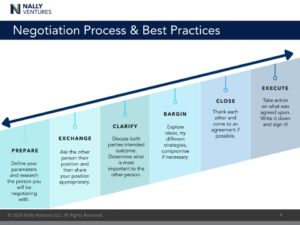
Want to foster great business relationships? Negotiation for the win(-win)!
Master the art of give-and-take
A great business relationship is built on collaboration. Neither party has all the answers, so working together is far more productive and likely to yield positive results. This doesn’t mean both parties will always agree. That’s where negotiation comes in, with the goal of reaching a win-win outcome. Let’s look at a 6-step negotiation process to help you get there.
How to negotiate

Step 1: Prepare – Define your parameters and research the person you will be negotiating with.
Chances are, you’ve been negotiating since childhood (how many bites of broccoli before you can have dessert?) and that continues today: Where will you and your friend go for dinner? What movie will you watch with your partner? Who’s doing what part of that work or school project? What’s the deadline?
Negotiations are often done on the fly in our everyday lives, so it’s easy to dismiss the importance of preparation. But when a business deal is on the line, preparation is vital. Make sure you:
- Consider all the factors that will influence the negotiation—who, when, where, why, and how.
- Know your business, your goals and strategy, and what’s non-negotiable.
- Know the relationship you want to build or maintain with the other party.
- Anticipate the other person’s position. Answer key questions from both perspectives: What is my desired outcome? Their desired outcome? My/Their key interests? My/Their bargaining chips? My walkaway alternative (what I will do if they walk away—see “BATNA” below)? Their walkaway alternative (what they will do if they walk away)?
- Know levers & goals: What concessions are you willing to put on the bargaining table? Who in your organization has the decision-making power?
- Consider your “BATNA”: best alternative to a negotiated agreement. If this negotiation doesn’t work out, what’s your alternative? This is your benchmark—the baseline you will accept that meets your needs, vision, and ethics. If you can’t reach this baseline in negotiating, then you know it’s time to walk away.
Step 2: Exchange – Ask the other person their position and then share your position appropriately.
- Set the tone early and stay focused.
- Stop talking and start asking questions. Discover their buying criteria.
- Quantify the value you’re offering.
Step 3: Clarify – Discuss both parties’ intended outcomes.
Clarify, prioritize, and drill down to determine what is most important to the other person. LISTEN to what they really want.
- Identify the interests behind the position.
- Establish the other party’s pain points.
- Identify who the real decision-maker is.
Step 4: Bargain – Explore ideas, try different strategies, compromise if necessary, and problem-solve!
This is the give-and-take stage with the goal to emerge with a win-win outcome and a positive course of action.
- Look for alternatives and what-ifs.
- Know (and rehearse) your walk-away point. What are you willing to trade off instead of walking away?
- Avoid the bad strategy of “negotiating by continually conceding.” Learn how to say “no” and to invent options for mutual gain.
- Keep your emotions in check. Remember, this is supposed to be getting to an agreement that’s good for both of you.
Step 5: Close – Come to an agreement.
No negotiation is complete without a closing, which is something of an art in itself.* In general, you want to listen for questions that indicate a close is appropriate, such as questions about pricing and timelines, and ask questions that will help you get there:
- Is there anything else I can tell you?
- What can I do to get you what you need?
- What can I do to make this happen?
- What are the next steps? What I heard is…(details of the next steps).
Step 6: Execute – If a deal is agreed to, write it down, sign it, and implement it!
- Outline each party’s expectations and ensure that the agreement will be implemented effectively. This step often includes a written contract.
- Take action on what was agreed upon.
- Follow up to confirm the implementation is going smoothly.
Negotiation is a valuable skill in business and in all parts of life. And it takes practice. But success starts long before you sit with someone at the bargaining table. The process of reaching a deal really starts with the first contact. Taking the time to build a relationship from day one is the best negotiation tactic of all.
*We cover closing and other negotiating techniques in detail in our training. See how this can prepare your team to excel and create better outcomes for your customers. Reach out to our program director, Jen Walls, for details.
How can we help your leaders and business excel?
